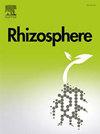Increased fine roots, exudates and altered rhizospheric functions in the invasive plant Sphagneticola trilobata compared to the native Sphagneticola calendulacea
IF 3.4
3区 生物学
Q1 PLANT SCIENCES
引用次数: 0
Abstract
The invasion of exotic plants has a significant impact on terrestrial ecosystems, while the underlying mechanisms are diverse and sometimes contradictory. A systematic study on root morphology and functions in the rhizosphere would shed light on a convincing invasion mechanism and practical control measures. We conducted a greenhouse experiment with the invasive Sphagneticola trilobata and the native Sphagneticola calendulacea to and systematically investigated their root morphology and rhizospheric functions. The growth, photosynthesis, root morphology and exudates, as well as the microorganisms in the rhizosphere were measured. The invasive S. trilobata not only grew faster and better, but also had a higher organic acid content in the root exudate than the native S. calendulacea, although their exudate chemical properties were similar. The invasive S. trilobata also had a greater amount of fine roots and a higher SRL than the native S. calendulacea, allowing for more root exudates to support the growth and reproduction of soil microbes, which in turn regulate the plant's nutrient uptake. We also found that S. trilobata alters the microbial composition of the soil, and influenced the β-diversity of fungi. These coordinated responses could promote the growth performance of S. trilobata and facilitate its invasion. Our results provide a framework for the mechanisms of plant invasion from the perspective of ecological processes in the subsurface rhizosphere.
入侵植物三叶球藻与本土植物金盏球藻相比,细根、分泌物增加,根际功能改变
外来植物的入侵对陆地生态系统有着重要的影响,但其潜在的机制是多种多样的,有时甚至是相互矛盾的。对根际根的形态和功能进行系统研究,将有助于揭示侵染机理和切实可行的防治措施。本文以入侵型三叶球藻和本土型金盏球藻为材料,对其根系形态和根际功能进行了系统的研究。测定其生长、光合作用、根系形态、根系分泌物及根际微生物数量。外来入侵的三叶金盏花不仅生长速度快、质量好,而且根系分泌物中有机酸含量也高于本土金盏花,但其分泌物化学性质相似。入侵的三叶草也比本地的金盏菊有更多的细根和更高的SRL,允许更多的根渗出物来支持土壤微生物的生长和繁殖,从而调节植物的营养吸收。我们还发现三叶霉改变了土壤微生物组成,并影响了真菌的β-多样性。这些协同反应促进了三叶虫的生长性能,为其入侵提供了便利。我们的研究结果从地下根际生态过程的角度为植物入侵机制提供了一个框架。
本文章由计算机程序翻译,如有差异,请以英文原文为准。
求助全文
约1分钟内获得全文
求助全文
来源期刊

Rhizosphere
Agricultural and Biological Sciences-Agronomy and Crop Science
CiteScore
5.70
自引率
8.10%
发文量
155
审稿时长
29 days
期刊介绍:
Rhizosphere aims to advance the frontier of our understanding of plant-soil interactions. Rhizosphere is a multidisciplinary journal that publishes research on the interactions between plant roots, soil organisms, nutrients, and water. Except carbon fixation by photosynthesis, plants obtain all other elements primarily from soil through roots.
We are beginning to understand how communications at the rhizosphere, with soil organisms and other plant species, affect root exudates and nutrient uptake. This rapidly evolving subject utilizes molecular biology and genomic tools, food web or community structure manipulations, high performance liquid chromatography, isotopic analysis, diverse spectroscopic analytics, tomography and other microscopy, complex statistical and modeling tools.
 求助内容:
求助内容: 应助结果提醒方式:
应助结果提醒方式:


